From establishing clubs, their structures and departments from the ground up with the continued expansion of the league to negotiating creative ways of making their squad fit the rules regarding squad sizes and player registration, Major League Soccer presents Sporting Directors, Chief Soccer Officers, Club Executives and everyone else involved with the running of clubs with unique challenges and tasks.
One of the challenges they must deal with, which is a bit more relatable for club decision-makers all over the world, concerns player recruitment — using the transfer market to strengthen their squad and gain an advantage over their rivals for the new season.
The growing challenge in this area for MLS clubs at the moment requires them to find new markets other than those already well-established in the league, but with that, they must contain a great deal of competition for the very best players coming out of those markets.
For instance, Argentina has been a hotbed for MLS recruitment in recent years. However, the likes of Inter Miami, with Chris Henderson leading the sporting project and Albiceleste icon Lionel Messi in the squad, have currently got a very tight grip on that market, as evidenced by the 2024 winter transfer market, which saw a top young talent in Federico Redondo — highly sought-after not just in the US but all around the football world — make his way from Argentina to MLS and commit himself to the Florida-based outfit.
Henderson and all of those involved in the management of Inter Miami have spoken of the vision not just to build Inter Miami as a top competitor in MLS but as a global brand. They won’t be the only team in the US aiming to achieve this, but with household names around the football world such as Messi, Luis Suárez, Sergio Busquets and Jordi Alba in the squad, David Beckham as the President and now the ability to lure top young talents coveted by clubs and admired by youth football savvy fans alike, they’re certainly doing an excellent job of building their brand and setting an example for others to try and emulate.
Still, that doesn’t mean other clubs should do precisely the same as them. In fact, with such established competition now in the Argentinian market, including Inter Miami along with the likes of Atlanta United, who have Thiago Almada on their books — signing him from Vélez Sarsfield back in 2022 — it may be wise for clubs to learn from the lessons taught by the likes of Inter Miami in this regard but apply the lessons in different ways. Learn from inspiration, but don’t aim to shadow it. Apply the principles acquired but in new, innovative ways to carve your own path.
Attracting talent from different parts of the world can help build a brand and help a team find a competitive edge both in the transfer market and on the pitch. You’ve got a lot of big fish from the MLS and elsewhere focusing on the Argentinian market, for one, right now — but plenty of other markets remain to be captured.
This recruitment analysis piece will highlight three MLS clubs who look to be on the path to carving their niche in the MLS transfer space, establishing themselves as the masters of their own particular area(s) of focus, further growing their brand in that region among fans, as well as their reputation among players as a viable option to enhance their career.
We’ll use data and statistics from recent transfer windows as well as comments and research into key figures involved with recruitment from these particular clubs to highlight why these three clubs are worth keeping a close eye on when it comes to MLS recruitment over the coming transfer windows.
Common MLS markets
Before we look at the clubs we’ve picked out for this analysis, we’re going to kick off our piece by establishing what the common markets are for MLS sides to shop in at present.
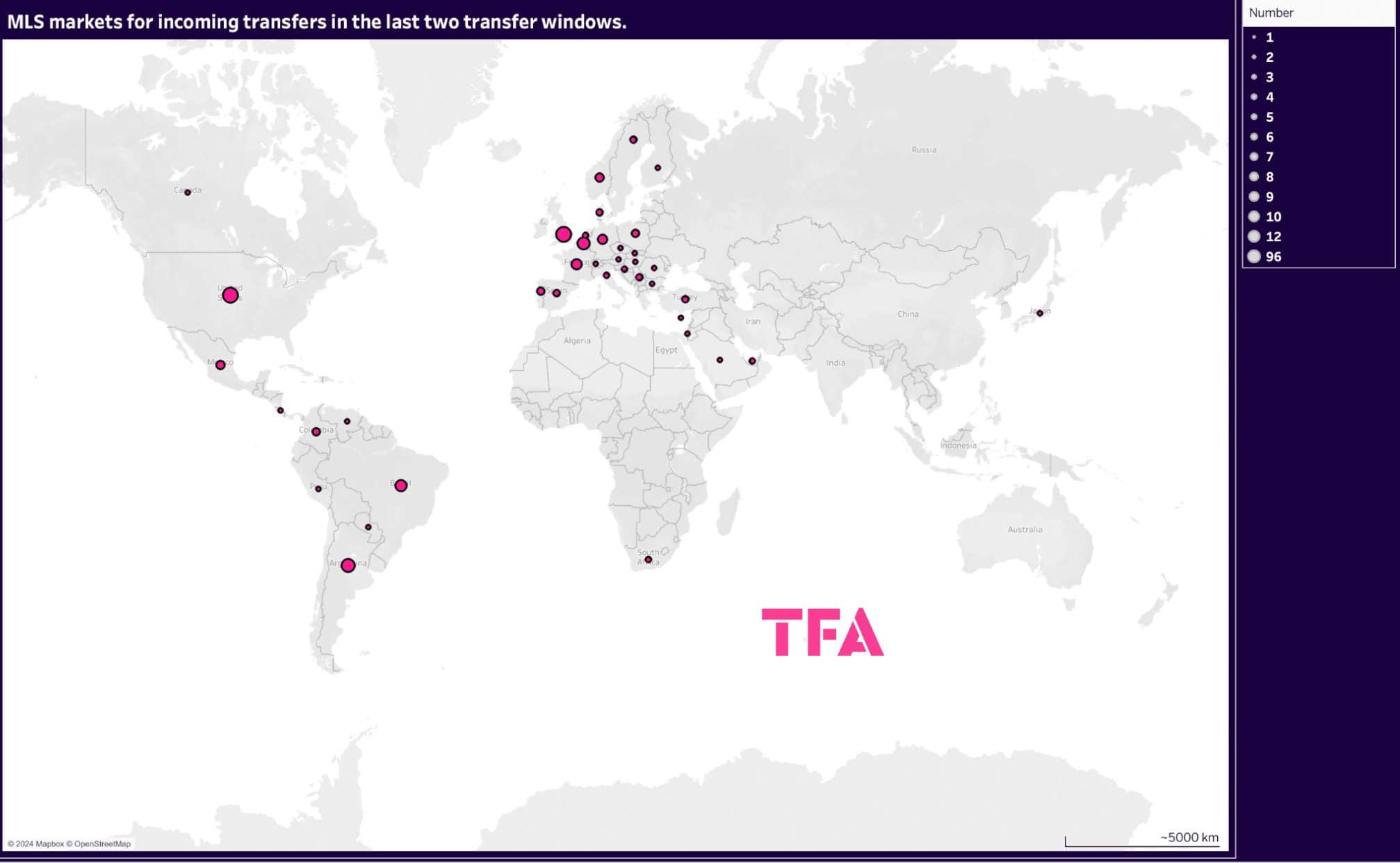
Firstly, figure 1 highlights from where MLS teams made their new signings within the past calendar year — the bigger the circle, the more players arrived from those particular regions.
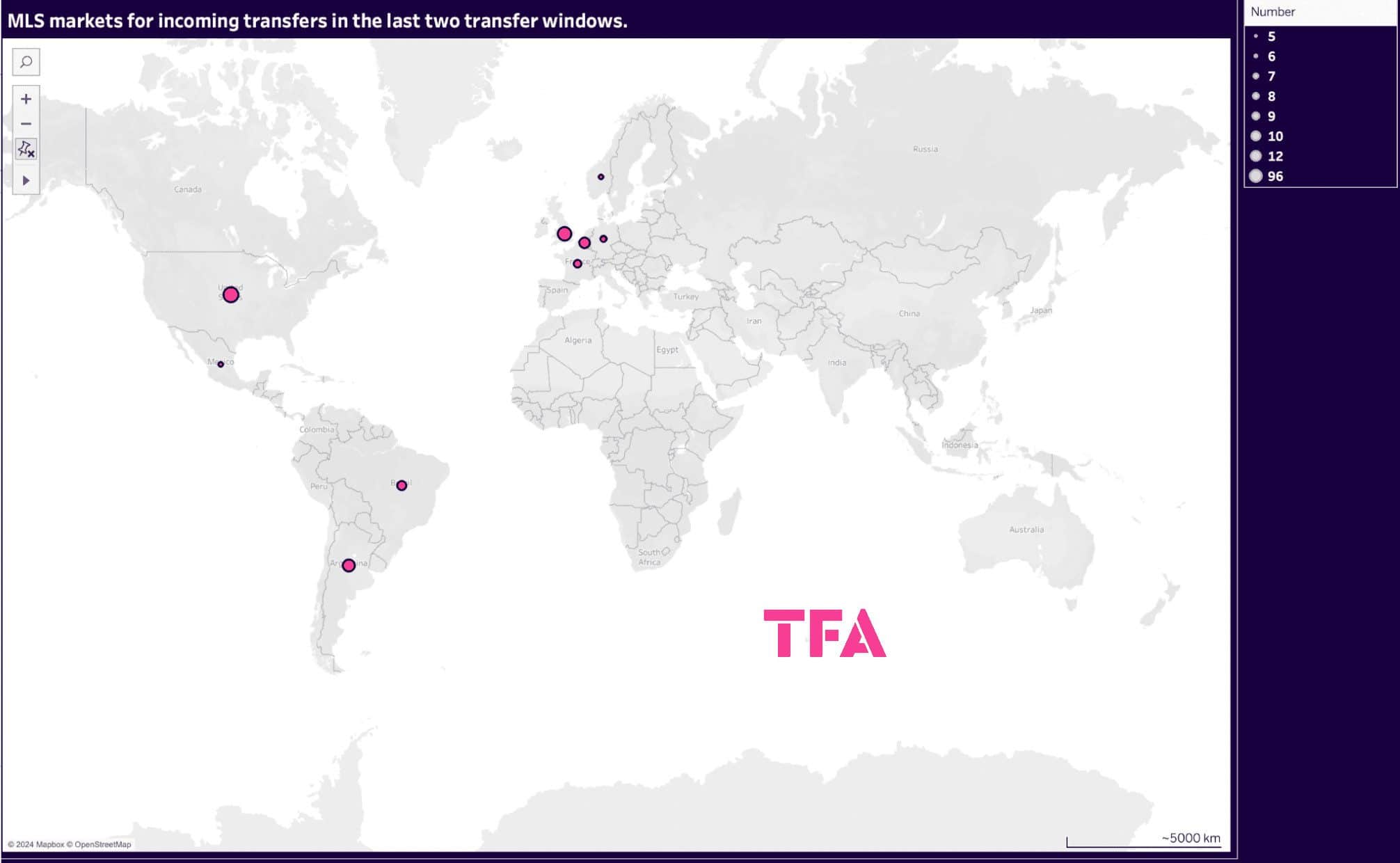
Moving on to Figure 2, we’ve removed all but the top nine markets—the USA, England, Argentina, Belgium, Brazil, France, Germany, Norway, and Mexico.
Of course, the US dominates the market, with 96 players moving from other teams in the US — MLS or otherwise — to MLS teams.
England and Argentina are the only other markets to see double-figures (12 and 10, respectively) for MLS signings.
Minnesota United
Tim Bogert, a writer from The Athletic, detailed that MLS teams see Europe (outside of the top-five leagues) and Asia as markets with a lot of untapped potential for transfers. Bogert also indicated that Minnesota United is one team working hard on its scouting network in South Korea—essentially hinting to watch this space for The Loons to make moves in that particular market.
Manny Lagos heads Minnesota’s sporting project as Chief Development Officer and Senior Technical Advisor, with Andrew Gregor having been brought in as Head of Scouting just under a year ago after a lengthy tenure on the coaching team with Portland Timbers’ youth academy.
Minnesota joined the MLS in 2017, and Lagos has been involved in some capacity, overseeing the sporting project right from the very beginning. Throughout his time at Minnesota, Lagos has frequently pointed to Portland Timbers as an example for Minnesota to follow while the club was establishing itself and being built up; now, a former member of the club has been brought into Minnesota to lead the recruitment process — one who also has plenty of experience developing youth and overseeing young players’ transition from academy to first team at MLS level, in Gregor.
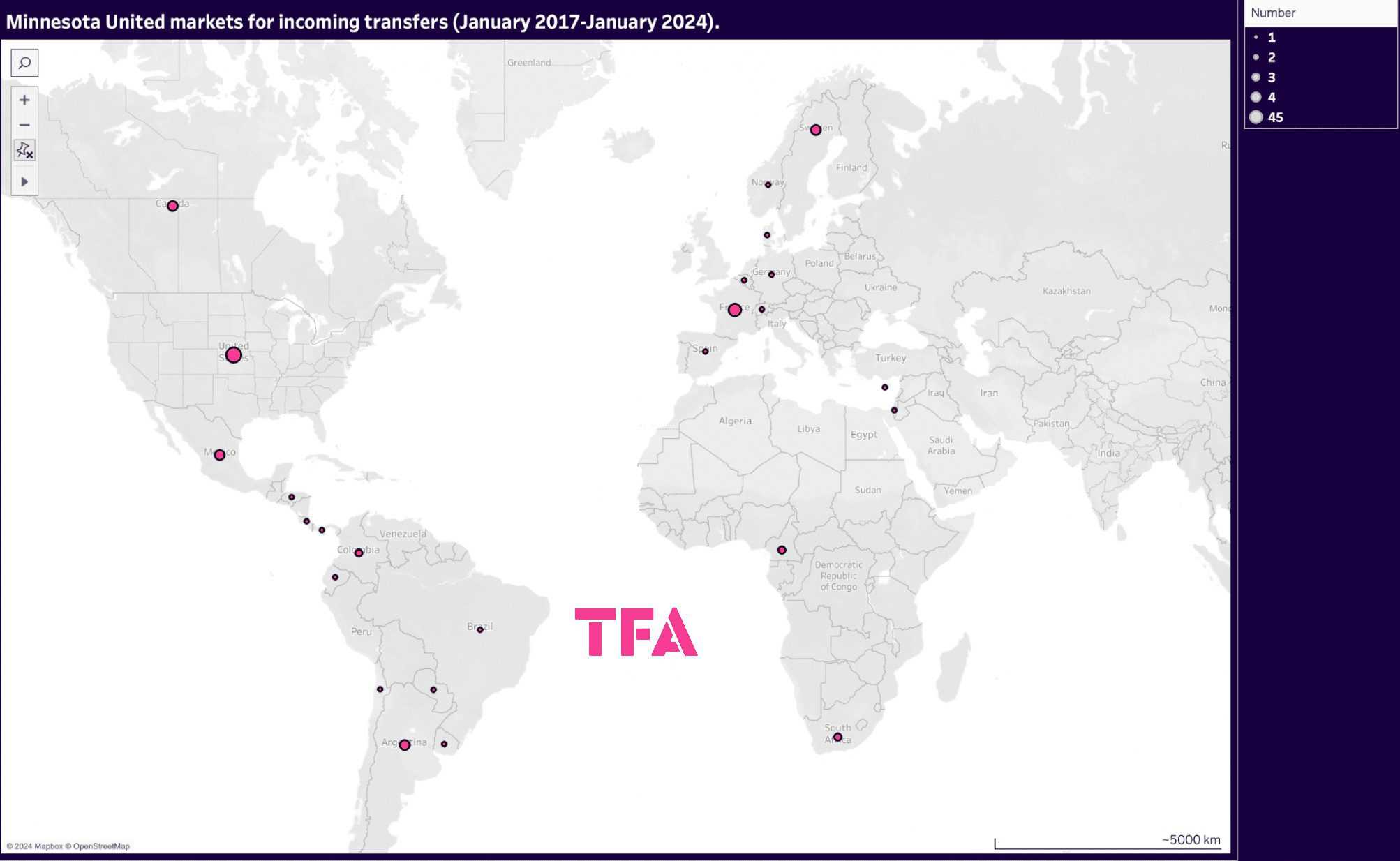
As is the trend for the league as a whole, Minnesota have primarily signed players from within the US, though it’s worth mentioning about a quarter of those signings were made in the club’s first season.
In recent years, signings have come from further afield more often than not, with France (five signings), Sweden (four signings) and Mexico (three signings) among their top-five most popular markets.
It’s also noteworthy how much attention Minnesota have paid to Africa in their young life as an MLS team, with two signings from South Africa and two from Cameroon on their record.
The Loons have been active in looking for an edge in the transfer market throughout their existence, with reports of extensive scouting in other African markets, such as Ghana, also public knowledge.
With this in mind, along with the reports of their hard work in relation to the establishment of a strong scouting presence in South Korea, they appear to be one of the more bold and adventurous teams when it comes to looking outside the typical markets when it comes to recruitment, something that may well stand to them and provide them with an edge should they successfully establish themselves and build a positive reputation where they seem keen to build connections.
There’s certainly plenty of untapped potential in the markets they’ve identified, and they seem to be at least a step ahead of their domestic rivals in some of the regions they’re working on.
St. Louis City SC
St. Louis City only had their first MLS season a year ago, but already, it seems clear that they aim to do certain things, including their recruitment, a bit differently from their domestic rivals. Lutz Pfannenstiel, former Sporting CEO at Fortuna Düsseldorf and long-time Head of International Relations and Scouting at Hoffenheim, is the Hellcats’ Sporting Director, and his career is full of indicators he is very much a forward-thinker with a mind to discovering untapped potential.
During his time at Hoffenheim, Pfannenstiel played a pivotal role in setting up a programme that saw youth footballers from India get an opportunity to train with the Bundesliga side’s academy, with the current St. Louis director explaining that he saw “huge potential” in the region.
As a result, St. Louis City seem well-placed to find a competitive edge, be that in the senior transfer market or in the youth development department, in regions their competitors may not be taking full advantage of at the moment, potentially establishing themselves as a place to go for players from certain markets.
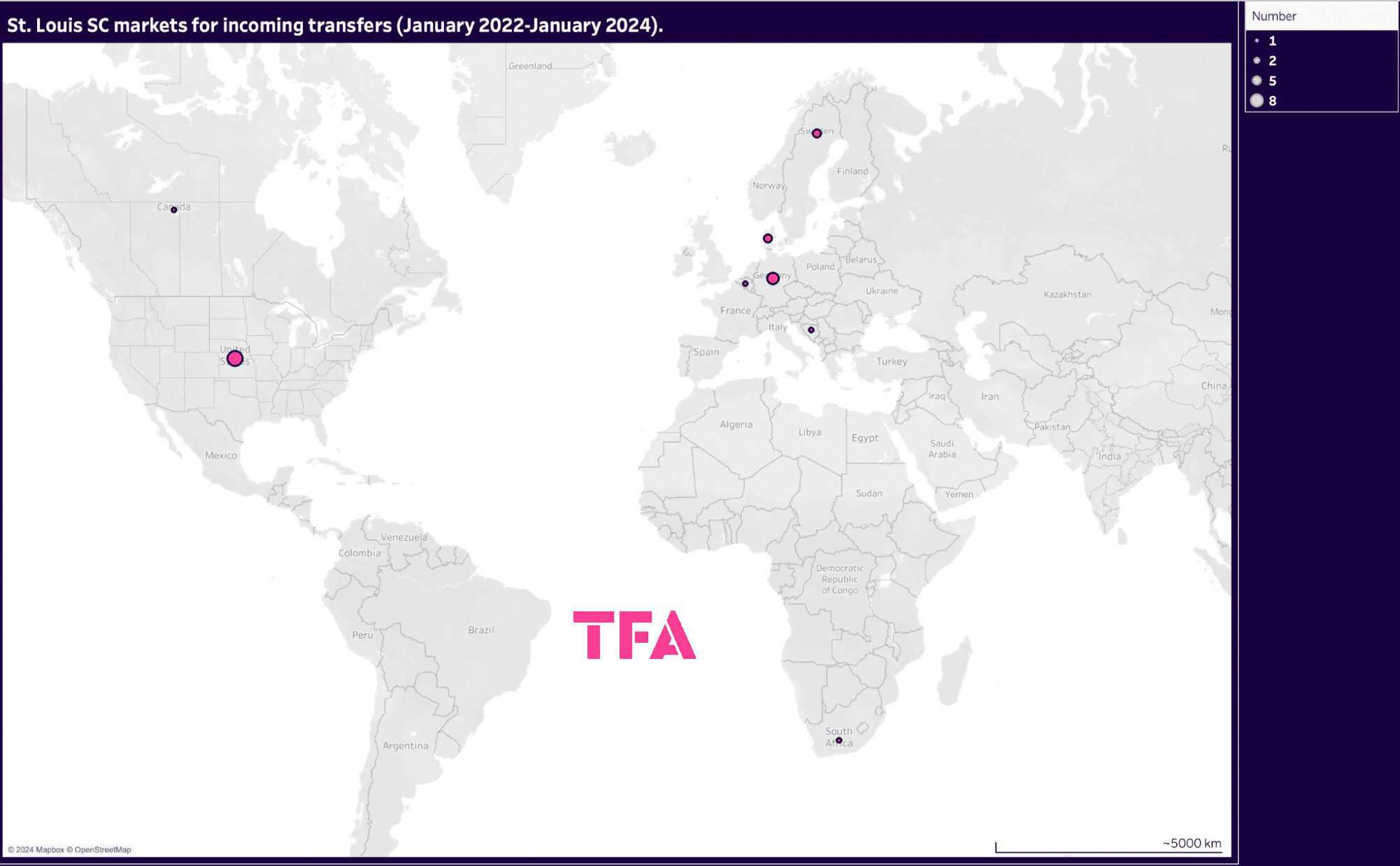
St. Louis has only had five transfer windows to build the squad it has thus far. That said, the proportion of talent it’s recruited from outside the US is relatively high compared to league averages—especially considering one of these transfer windows was it’s first when it just had to establish a squad capable of meeting league requirements and competing in the division.
Of 22 signings thus far, eight have come from within the US — just over a third. Meanwhile, five have come from Germany, where Pfannenstiel is obviously well connected, along with two from Denmark and two from Sweden.
The Hellcats have also made one permanent signing from each of the following markets — England, Bosnia and Herzegovina, South Africa, Canada and Belgium — in their young history.
With Pfannenstiel overseeing the sporting project and heavily involved with their recruitment processes, St. Louis seem well positioned to take advantage of European markets, be that Germany or markets like Sweden or Denmark outside of Europe’s top-five leagues where it appears there’s plenty of growth for MLS clubs to establish themselves as a viable transfer destination.
FC Dallas
Lastly, we’re going to head to Texas, where FC Dallas’ sporting project is led by André Zanotta — the club’s Chief Soccer Officer and Sporting Director.
Zanotta was recently promoted to the Chief Soccer Officer and Sporting Director position, having previously been Technical Director — a role now being performed by fellow Brazilian Sandro Orlandelli, former Technical Coordinator with Internactional and Red Bull Bragantino, respectively, who also worked as a scout for the Brazil national team, Manchester United and Arsenal — with a focus on South America — earlier in his career, bringing a wealth of experience with the South American market.
Club President Dan Hunt expressed his excitement over the club’s technical department shakeup while also, notably, stating:
“Soccer has such a global footprint, as the game evolves over time, so does the business side… As Chief Soccer Officer, Zanotta will be in charge of all things related to the soccer business. The role of technical director has changed in the global game; we see it happening in MLS.”
Indeed, FC Dallas appear keen to make a mark on a global scale, and this would include the scouting and recruitment departments — both at the senior level and youth level, with Zanotta having previously expressed his pleasant surprise at the growth in the prominence of youth development in the MLS and acknowledged the changing perception of the MLS around the world when it comes to scouting and recruitment for clubs from other regions.
In 2020, he explained how the quality of youth football in the country had skyrocketed since he’d spent a semester in Texas back in 1997 as a student before saying of FC Dallas’ USL affiliate North Texas: “One thing we’re doing with North Texas is bringing in young players from top places… We try to bring interesting young profiles from other countries that could project to the first team.”
In addition to looking to bring in good young players who could contribute to Dallas’ first team, he doesn’t shy away from the fact some players may see the club as a stepping stone, explaining he’s familiar with this from his work in Brazil where players also have dreams of springboarding to one of the major European leagues — knowledge and awareness that could prove beneficial for FC Dallas if they leverage it to becoming a popular destination for skilful, ambitious players — and where better to find them than South America where they are very well equipped to spot and acquire talent?
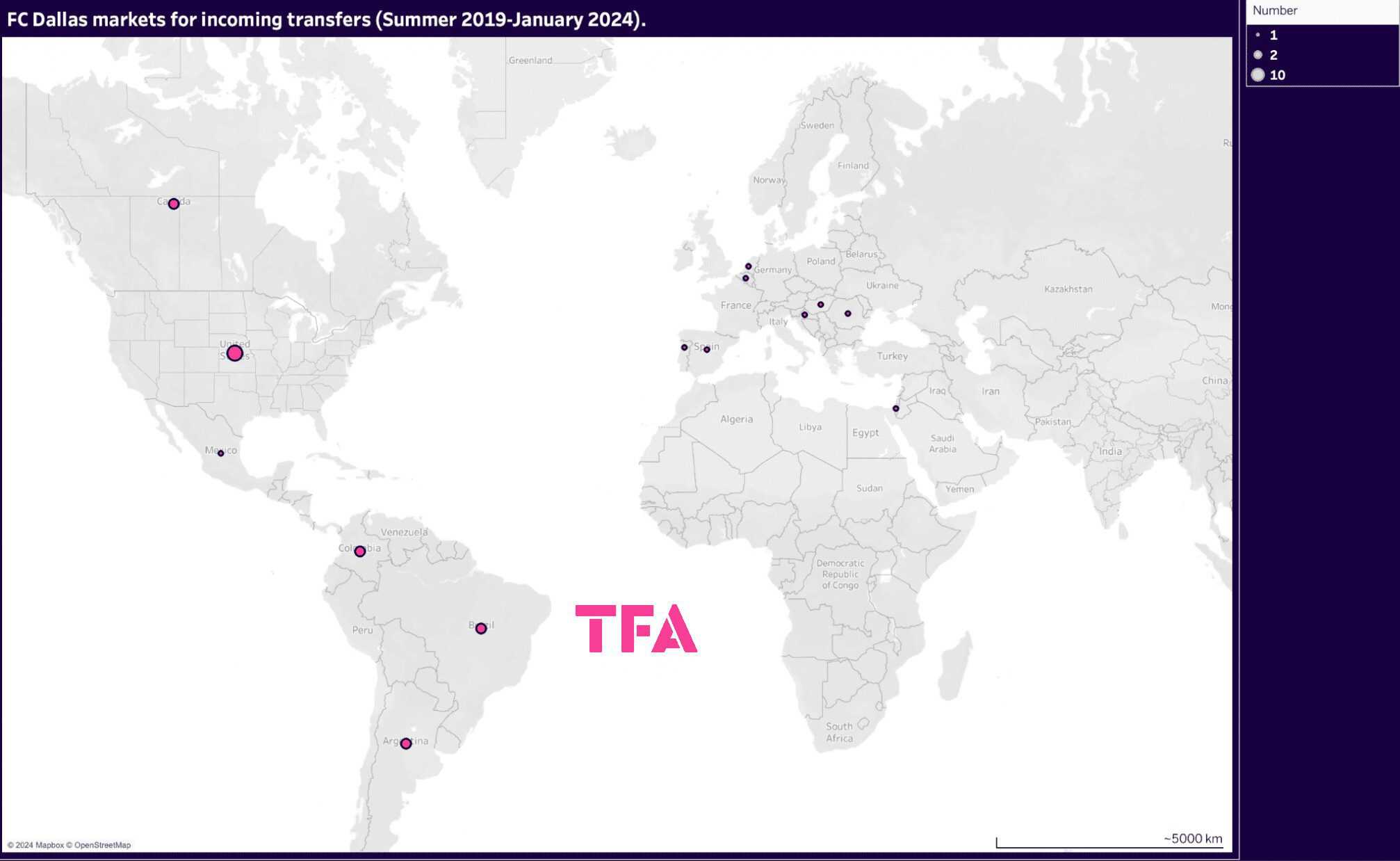
Since Zanotta’s first transfer window at the club—the 2019 summer window—Dallas has been active in South America, with two coming in from Brazil—a growing market that could potentially reach and even eclipse the popularity of Argentina in the US division—and two arrivals from Argentina and Colombia, respectively.
A scattering of signings from around Europe—one from each of Spain, Portugal, Belgium, Hungary, Croatia, and the Netherlands—join the 10 from the US itself, two from Canada, one from Mexico, and one from Israel to sum up Dallas’ 28 permanent signings at this time.
With Zanotta’s growing power and trust at the club along with the arrival of Orlandelli, expect Dallas’ use of the South American market to grow — but perhaps outside of the potentially saturated Argentinian market.
Signings from Brazil are likely to continue on an upward trajectory in Dallas — both for the senior squad and the youth team ‘North Texas’, which Zanotta seems keen to leverage as a useful tool for enhancing the quality of the senior squad.
Conclusion
To conclude this recruitment analysis, we feel these three teams are going to be some of the more exciting ones to watch when it comes to MLS recruitment over the coming years, potentially growing their brands and their all-important quality on the pitch via intelligent and unique processes.
Whether or not this will be enough to help them challenge for MLS glory remains to be seen, but they certainly all seem well-placed to find a competitive edge over their rivals in some ways.





Comments